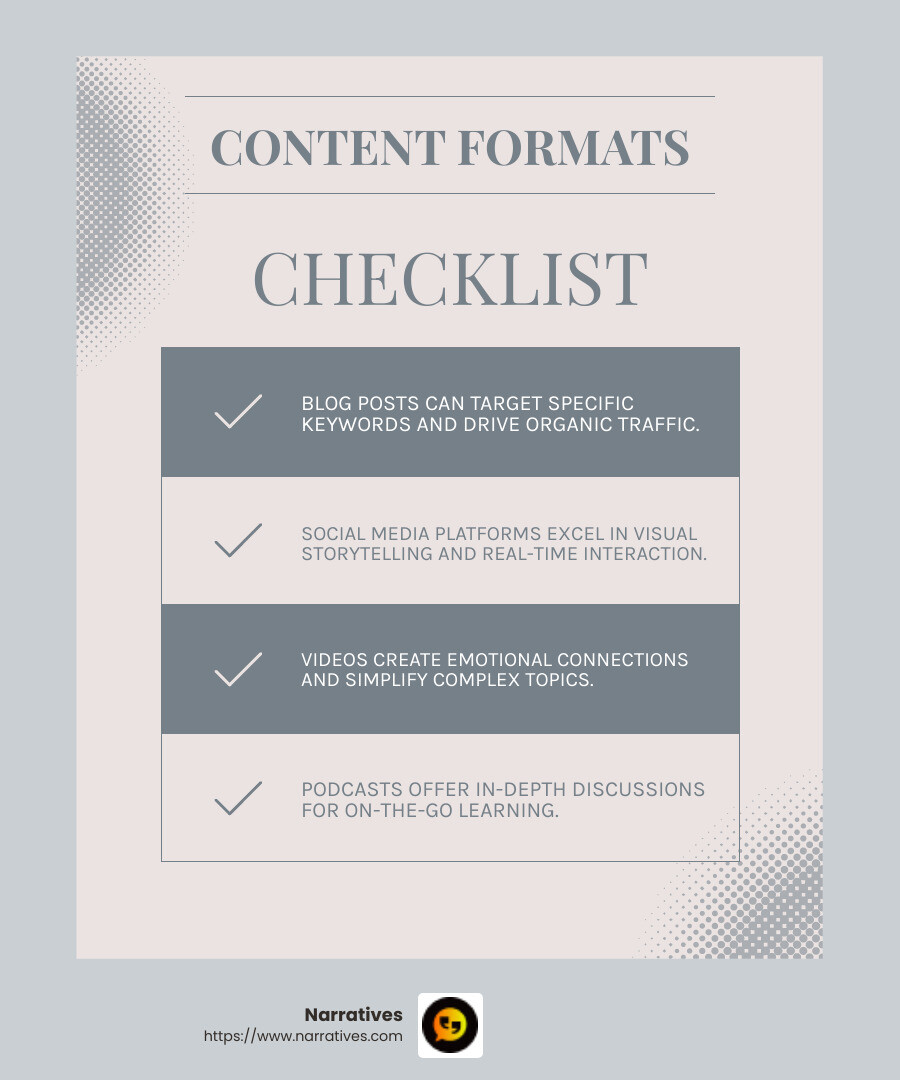From Idea to Impact: Understanding Content Creation

Content creation is more than just a marketing trend—it's a powerful tool that organizations, particularly non-profits, can leverage to amplify their mission and stories. At its core, content creation involves the process of developing and sharing media in various formats to engage targeted audiences effectively. For non-profits, the approach becomes even more impactful as it merges with digital storytelling to convey meaningful narratives that resonate deeply with communities and potential supporters.
Here are key points to understand about content creation:
- Purpose: It builds brand awareness, establishes trust with your audience, and can drive donations and engagement for non-profits.
- Format: Content comes in many forms, including blog posts, videos, social media updates, and podcasts, which offer unique ways to connect with your audience.
- Impact: Well-crafted content can make a difference in amplifying voices, especially for organizations focused on social justice and advocacy.
In a world overwhelmed by information, the ability to tell compelling and authentic stories is invaluable. Non-profits often find themselves in situations where their work is crucial, but their resources limited. Content creation allows them to translate their mission into relatable, visual stories, reaching more people and fostering a sense of community and action.
With a focus on ethical storytelling and emotional impact, content creation is not just an operational activity for non-profits—it's a strategic necessity that drives change, awareness, and growth.
Content creation terms made easy:
The Essence of Content Creation
Defining Content Creation
Content creation is the art and science of crafting media that speaks directly to your audience's needs, interests, and emotions. It's not just about putting words on a page or images on a screen. It's about solving problems, answering questions, and entertaining in a way that resonates with your target audience.
Imagine you're a non-profit aiming to raise awareness about environmental conservation. Your content should not only inform but also inspire action. Whether it's through a blog post detailing the effects of climate change or a podcast featuring interviews with environmental experts, the goal is to engage and motivate your audience.
Media formats are the building blocks of content creation. They include:
- Blog Posts: Great for educating and providing in-depth information. They help build trust and demonstrate expertise.
- Social Media: Ideal for quick updates and engaging directly with your audience. Platforms like Instagram and TikTok excel in visual storytelling.
- Videos: Perfect for creating emotional connections through visuals and sound. They can cover complex topics in an accessible way.
- Ebooks: Offer detailed insights and can be used to collect audience information for future engagement.
- Podcasts: Allow for in-depth discussions and are perfect for on-the-go learning.
Types of Content
Each content format serves a purpose and caters to different audience preferences. Let’s break it down:
Blog Posts: These are the backbone of many content strategies. They are excellent for targeting specific keywords and driving organic traffic to your site. A well-written blog post can educate and establish your authority on a subject.
Social Media: Platforms like Facebook, Instagram, and LinkedIn allow for real-time interaction. Social media is fantastic for building a community and fostering direct engagement. Quick tips, behind-the-scenes looks, and interactive polls can create a lively dialogue with your audience.
Videos: Whether it's a quick tutorial or a heartfelt documentary, videos have the power to convey stories in a way that written content cannot. They are particularly effective for showcasing real-life impact and personal stories.
Ebooks and Whitepapers: These are comprehensive guides that dig deeply into a topic. They are useful for audiences seeking detailed information and can help establish your organization as a thought leader.
Podcasts: Perfect for storytelling and in-depth discussions, podcasts can reach audiences who prefer listening over reading. They allow for a more personal connection as listeners often engage with them during their daily routines.
In the field of content creation, understanding your audience is key. Knowing their preferences, challenges, and needs allows you to tailor your content effectively. When done right, content creation not only informs but also inspires, leading to meaningful engagement and action.

Moving forward, we'll explore how crafting compelling stories can lift your brand and connect with audiences on a deeper level.
Crafting Compelling Stories
Aligning with Strategic Goals
Crafting compelling stories is an art that aligns seamlessly with strategic goals. At its core, brand storytelling is about creating narratives that resonate emotionally with your audience. By weaving your brand's mission into every piece of content, you ensure that your audience not only understands but also connects with your purpose.
To achieve this, it's crucial to use audience insights. Understanding what your audience cares about helps you tailor stories that speak directly to their experiences and aspirations. This connection fosters deeper engagement and encourages your audience to take action.
A well-crafted content strategy is the backbone of this process. It involves identifying key themes that align with both your brand's objectives and your audience's interests. This strategic alignment ensures that every story you tell is purposeful and impactful.
Tools and Techniques
Content creation tools play a vital role in bringing stories to life. From AI tools that assist in generating ideas to multimedia elements that improve storytelling, these resources are invaluable.
AI Tools: Leveraging AI can streamline the content creation process. Tools like HubSpot's AI Content Writer can generate ideas and even draft content, freeing up time for creative refinement. AI can also analyze data to provide insights into audience behavior, helping you tailor your stories more effectively.
Multimedia Elements: Incorporating visuals, audio, and interactive components can lift your storytelling. Videos, infographics, and podcasts add depth and dimension, making your content more engaging. For instance, videos can evoke emotion through visuals and sound, while infographics can simplify complex data.

By using these tools and techniques, you can create stories that not only captivate but also drive your strategic goals forward. The key is to maintain a balance between technology and creativity, ensuring that your stories remain human at their core.
As we dig deeper, we'll explore how these strategies can be particularly effective for non-profits, highlighting the power of storytelling in driving social impact and elevating underrepresented voices.
Content Creation for Non-Profits
Elevating Voices
In the field of content creation, non-profits have a unique opportunity to lift underrepresented voices and drive social impact. At the heart of this effort is community-driven storytelling, which places the experiences and stories of real people front and center.
Video content is a powerful tool for this purpose. It allows non-profits to showcase the real-life impact of their work in a way that is both engaging and emotional. For instance, a short documentary featuring the journey of a community member can highlight the transformative effect of a non-profit's initiatives. This not only brings visibility to those who might otherwise be unseen but also fosters a deep connection with viewers.
Multimedia storytelling goes beyond video. It encompasses various formats like podcasts and interactive content, which can provide a platform for voices that need to be heard. By using a mix of media, non-profits can create a rich mix of stories that resonate on multiple levels.
Impact stories are another essential component. These narratives focus on the tangible outcomes of a non-profit's work, illustrating how specific projects have changed lives. Sharing these stories helps to build a narrative of hope and progress, encouraging further support and engagement from the audience.
Building Trust and Visibility
For non-profits, building brand awareness and trust is crucial. Trust is the foundation of any successful relationship, especially when it comes to engaging supporters and potential donors.
Trust-building begins with transparency. Sharing behind-the-scenes content and honest testimonials can humanize a non-profit's brand, making it more relatable and trustworthy. When audiences see the real people behind the mission and the genuine impact of their contributions, they are more likely to engage and support the cause.
Audience engagement is also key. Interactive content like polls, quizzes, and live Q&A sessions can foster a sense of community and involvement. When people feel like they are part of the story, they are more likely to become advocates for the cause.
By strategically using content creation to lift voices and build trust, non-profits can improve their visibility and drive meaningful change. We'll address some frequently asked questions about content creation, exploring how these strategies can be effectively implemented.
Frequently Asked Questions about Content Creation
What is content creation?
Content creation is the art and science of crafting various types of media to engage and connect with your audience. It involves developing and sharing materials like blog posts, videos, podcasts, and more to solve problems, answer questions, or entertain.
The goal is to build a relationship with your audience by providing value. This process is essential for businesses and non-profits alike, as it helps build brand awareness and establish trust.
How can content creation benefit non-profits?
For non-profits, content creation is a powerful tool for amplifying their mission and showcasing their impact. It allows them to:
Lift underrepresented voices: Through storytelling, non-profits can highlight the experiences of those they serve, giving a voice to communities that are often unheard.
Build trust and visibility: Sharing authentic stories and transparent operations helps establish credibility and trust with supporters and donors.
Drive engagement and support: Interactive content encourages audience participation, creating a sense of community and increasing advocacy for the cause.
By strategically using content, non-profits can improve their impact and foster deeper connections with their audience.
What tools are essential for content creation?
To streamline the content creation process, several tools can be invaluable:
Canva: For creating visually appealing graphics and social media posts.
HubSpot Blog Ideas Generator: To brainstorm fresh blog post ideas when creativity runs dry.
Vidyard: A video hosting platform that allows for easy video customization and sharing.
Anchor: A user-friendly platform for creating and distributing podcasts.
These tools help simplify the creation process, allowing you to focus on crafting compelling content that resonates with your audience.
Conclusion
At Narratives, we believe that content creation is more than just producing media—it's about telling stories that matter. Our mission is to empower non-profits and purpose-driven organizations by elevating underrepresented voices through powerful storytelling. By crafting emotionally resonant video and multimedia content, we help these organizations share their impact stories in a way that inspires action and builds trust.
Domain authority is crucial in the digital landscape. By focusing on broad, underused storytelling-related keywords, we aim to establish Narratives as the go-to partner for digital storytelling. This strategy not only differentiates us from others but also improves our visibility and credibility.
Our approach to content is strategic and intentional. We use blog content as a long-term investment to rank for long-tail, high-intent, and location-specific keywords. This builds consistent, organic traffic, supporting inbound lead generation and increasing brand awareness.
Our commitment to content creation is about making a meaningful impact. By aligning our efforts with the needs of non-profits and their communities, we foster deeper connections and drive change.
Want to learn more about how we can help your organization share its story? Find how Narratives can lift your impact.


